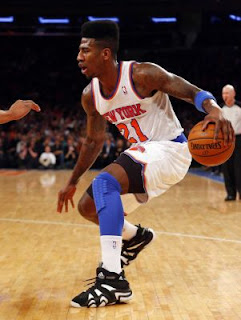 |
| There are more than a few fans side-eyeing Rose these days |
The cache that Derrick Rose has been building up throughout
his career is being spent more and more completely with every passing basket
made by the Bulls’ opposition. Rose was injured nearly a year ago today in
last year’s playoff series against the 76ers.
Since he was drafted number one by his hometown team, Rose has enjoyed
as much local and (because of the size and influence of Chicago) national
backing as any modern athlete who hasn’t won a title.
This manipulative emotional Adidas advertising spot and the poignant Rose press conference announcing
the launch of his shoe D Rose 3 are indicative of the type of full-fledged
support that Rose enjoyed during his arduous process of getting back on the
court post injury. During his journey to
recovery, the Bulls gutted out a 5th seed while being 2nd
to last in points scored per game (obviously missing their superstar point
guard), and battling through a litany of other injuries to other key players.
Every week after the All-Star game brought better and better
news about Rose. First, he was making
cuts. Then Rose was participating in
drills on the court; then he was playing well in practice. All that was left was for him to come back
onto the court and join his team.
Moreover, Iman Shumpert of the Knicks who also suffered a torn ACL
during the first round of the playoffs was back in January. The pressure began to mount.
 |
| Shumpert has been back since January, but has yet to return to his rookie form |
Fast forward to February when Rose’s brother and manager,
Reggie, insinuated that
Derrick wasn’t back playing because of the Bulls’ inactivity in the free agent
market. Add to that the fact that Derrick’s agent (former Bulls’ player and
executive BJ Armstrong) has a bit of a contentious relationship with the organization,
and suddenly the unshakable support had come undone. In game 2, Joakim Noah played on one foot
through his own injury, to lead the Bulls to a win that evened the series and
gave homecourt advantage to Chicago.
Rose has been a great player for the Bulls and even with him
at full strength the odds that they would beat the Heat and represent the East
in the NBA Finals are long. Still, as long
as he sits in those well-tailored suits and not in his snug jersey, there will
be contention. In his defense, if this
dilemma to play has shown the star (and players at large) is that there is no
loyalty in sports; not even from the fans.
Amongst my generation that grew up with free agency as
common place, the love for the name on the front of the jersey will always
supersede the love for the name that adorns the back. When players can leave at the drop of a hat
(or more likely, production) it is a defense mechanism to protect our hearts
and distance ourselves from players.
Let’s just hope that this hasn’t jaded us too badly, and gives Rose the
time he feels he needs to recover.







